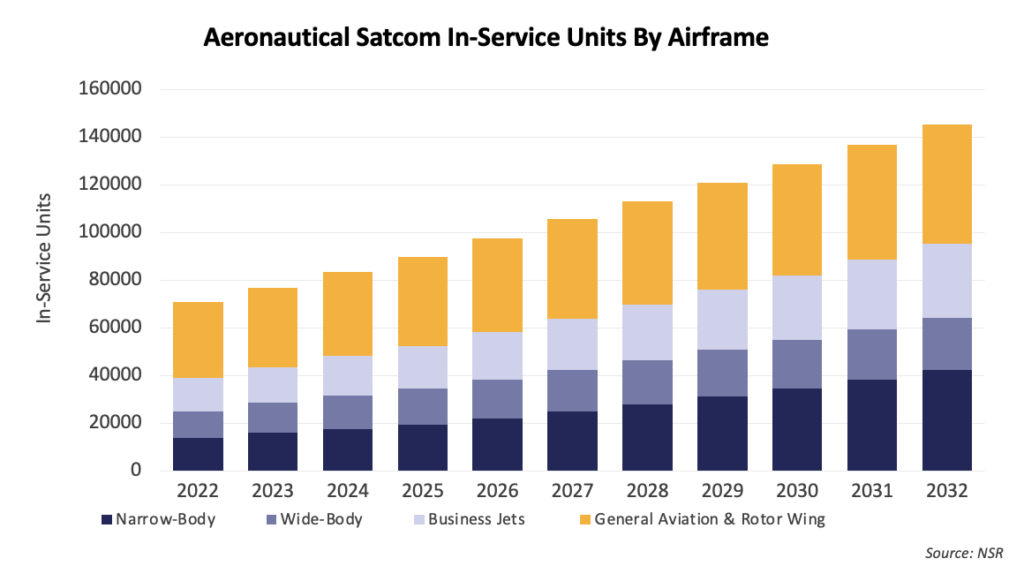Free Inflight Wi-Fi, But at What Cost?
The future of in-flight connectivity (IFC) holds tremendous potential for revolutionizing the passenger experience. Consider that connected aircraft more than doubled between 2021 and 2022, and in-service units grew by 6.5% from 2021 to over 70,000 units in 2022. NSR’s Aeronautical Satcom Markets, 11th Edition estimates the total addressable market to grow at 3.8% CAGR and exceed 210,000 airframes by 2032. IFC availability is now an item of choice when picking airlines/travel routes.

The Aero market is beginning to shape-up as LEO-HTS constellations and cutting-edge technology are being commercialized. A few disruptions will set the pace for the next few years, from LEO connectivity officially entering the scene late 2022, to the adoption of various digital and transformative services, such as electronically steered antennas. But beyond technological advancements and improved connectivity infrastructure, “free Wi-Fi” onboard will, and already has, introduced an interesting dynamic to Aero markets.
Free Wi-Fi for All?
ViaSat announced in March that it would provide connectivity to more than 1,000 Delta Aircraft, 70% of which are expected to be installed by the end of 2023. This came after Delta announced that it will offer free Wi-Fi to all Delta SkyMiles members onboard most domestic mainline flights. While Delta Airlines is not the first Airline to provide free internet access to passengers (think JetBlue, for example), it is the latest and arguable largest to offer such services to passengers. The deal sets the scene for Starlink, which has also officially launched free Wi-Fi services on Hawaiian airlines and JSX airlines.
At What Cost Though?
Offering free Wi-Fi to passengers can enhance their experience, increase customer satisfaction, and provide opportunities for businesses to engage with users. But this would not come without a cost (for airlines/SPs), or at least some trade-off. These are:
- Airlines could lose potential revenues from paid Wi-Fi services. Instead of charging passengers for internet access, they opt to provide it for free, which means they forego the direct income they could have earned from selling Wi-Fi packages.
- Providing free Wi-Fi to all passengers can result in a heavier load on the network infrastructure. This increased demand may impact the overall network performance, leading to slower connection speeds and reduced reliability. In the worst case, this could lead to loss of brand equity and sales.
Should Airlines Adopt the Free Wi-Fi Model?
The profitability of offering free Wi-Fi will vary depending on several factors, including the airline’s business model, customer base, and the costs associated with implementing and maintaining the service. While it may sound tempting to offer “juicy” free Wi-Fi offers, SPs and Airlines should not immediately abandon their current models for the “free Wi-Fi” model.
In the meantime, there are other important areas to focus on:
- SPs should focus on simplifying login and authentication processes. Implementing seamless connectivity methods, such as single sign-on (SSO) and passpoint to simplify and enhance the authentication process for Wi-Fi networks can reduce the hassle of entering login credentials and facilitate quick and easy access to the Wi-Fi network.
- SPs should partner with airlines to improve efficiency and optimization. Wi-Fi onboard is nowhere near perfect yet, therefore stakeholders can collaborate on implementing advanced network management techniques to better allocate resources while identifying and resolving connectivity or performance issues proactively. This will in turn reduce operational costs and enhance the overall user experience.
The Bottom Line
Airlines and Service Providers must consider whether current on-board equipment can support higher throughput rates. For airlines, critical questions for their vendors must be asked, including if the satellite operator or service provider has enough capacity density/supply? Do they have a multi-band/orbit strategy? What are the contractual and financial implications of switching from a paid model to a free one with any third-party providers or vendors?
NSR recommends that Airlines take a strategic approach before betting on the “Free Wi-Fi for all” model. Airlines must conduct a cost-benefit analysis to evaluate the life-cycle costs and financial implications of offering free Wi-Fi.
